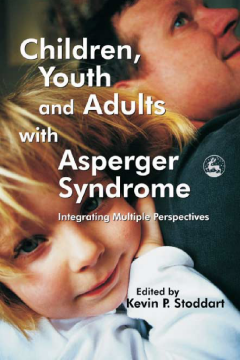
BOOK
Children, Youth and Adults with Asperger Syndrome
Kevin Stoddart | Rosina G. Schnurr | M. Mary Konstantareas | Barbara Muskat | Trina Epstein | Jennifer Saltzman-Benaiah | Gail Hawkins | Isabelle Henault | Tracie Lindblad | S. Wendy Roberts | Tamarah Kagan-Kushnir | Faye Mishna | Leon Sloman | Georgina Rayner | Paula Aquilla | Ellen Yack | Shirley Sutton | Lillian Burke | Peter Szatmari | Charmaine C. Williams | Jonathan Leef | Jeanette J. A. Holden | Ann Fudge Schormans | Peter Jansen | Fern Lee Quint | Donna Moon | Margot Nelles | Chris J. Dakin
(2004)
Additional Information
Book Details
Abstract
This book offers a comprehensive overview of clinical, research and personal perspectives on Asperger Syndrome, including contributions from parents and experts in the fields of psychology, social work, psychiatry, genetics, sexology and vocational counselling.
It includes first-hand accounts from adults with AS, highlighting their difficulties in areas such as social competence and education. Specialist perspectives on AS, including sexuality and relationships, finding and keeping employment and anxiety and depression are sensitively addressed. The viewpoints of parents explore experiences of parenting AS individuals. These varied approaches to living with AS complement the emerging literature on theory, research and practice in this area.
The broad scope of Children, Youth and Adults with Asperger Syndrome guarantees a wide readership among practitioners, students, parents, young people and adults with AS, educates service providers how to assist people with AS and suggests a model of interdisciplinary collaboration for administrators and funders.
This new emphasis in the field on the more able group with Autism Spectrum Disorders (ASD) is an important one for researchers and practitioners so this comprehensive book is a welcome addition to the literature. The editor has assembled a distinguished group of contributors, representing a wide range of disciplines and perspectives. The result is a comprehensive volume that adds immeasurably to our understanding of theory and practice in this important area. Although the contributors are primarily Canadian, their themes and reputations are international, and readers will appreciate the multitude of experiences they bring to these important issues. Clinical practice is highlighted but there is a solid section on theoretical perspectives as well. Of particular interest to many are the personal perspectives of individuals with ASD and their parents. The book will be of interest to parents, professionals, academics, and everyone else affected by or interested in ASD. It is a welcome addition to the literature and the editor and contributor are to be thanked for their efforts.
Gary B. Mesibov, Ph.D., Professor and Director, Division TEACCH, University of North Carolina
This book covers a lot of ground, but it does not stint on detail and thoroughness. It is easy to read and yet includes information and knowledge that will be useful in many different situations. It offers an insight into many important perspectives it is necessary to understand if one is to offer a useful response to Asperger's syndrome. This is a book that everyone should have the opportunity of reading and thinking about.
Good Autism Practice
Table of Contents
| Section Title | Page | Action | Price |
|---|---|---|---|
| How to use this book ............................................ vi | |||
| Preface ......................................................... ix | |||
| Introduction .................................................... x | |||
| Section I: Technologies that women are using worldwide .......... 1 | |||
| Agricultural technologies ..................................... 2 | |||
| Communications technologies ................................... 16 | |||
| Energy technologies ........................................... 40 | |||
| Food-processing technologies .................................. 62 | |||
| Health and sanitation technologies ............................ 88 | |||
| Income-generating technologies ................................ 114 | |||
| Section II: Practical ideas for women 's A.T. projects ........... 129 | |||
| Guidelines for development workers ............................ 132 | |||
| Guidelines for women and women ' s organizations ................ 146 | |||
| A sampling of women 's A.T. projects worldwide ................. 150 | |||
| Section III: Resources for women's A.T. projects ................ 155 | |||
| Appendix A: Appropriate technology centres worldwide .......... 157 | |||
| Appendix B: Appropriate technology journals ................... 161 | |||
| Appendix C: Appropriate technology catalogues ................. 165 | |||
| Appendix D: Sources of assistance for A.T. projects ........... 167 | |||
| Appendix E: A sampling of women's A.T. meetings ............... 171 | |||
| Appendix F: Tech and Tools resource people: A contact list .... 174 |
